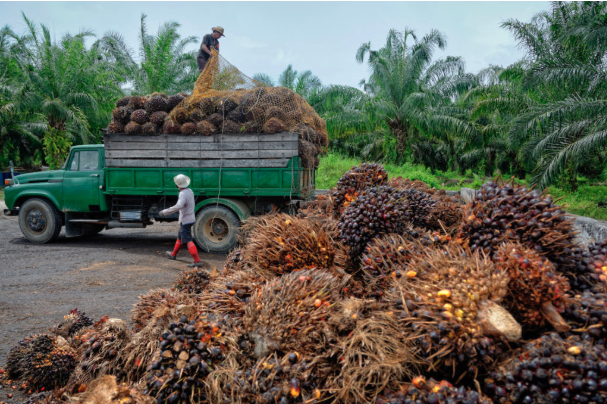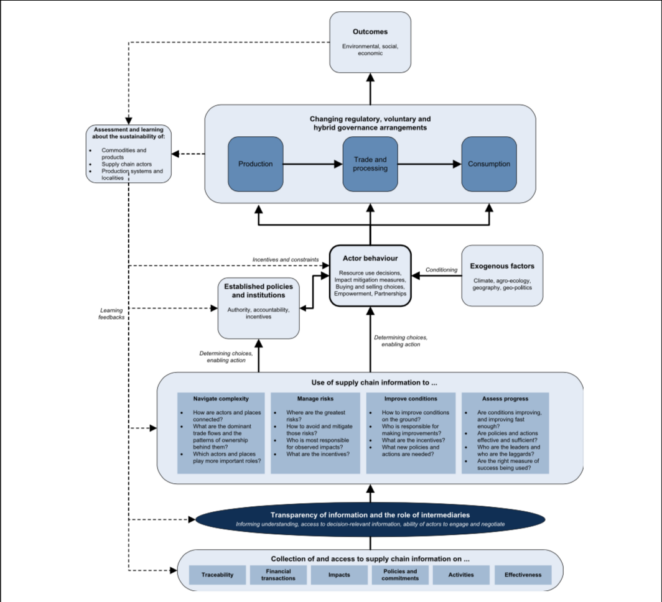Transparency and sustainability in global commodity supply chains

Introduction
Over the last few decades rapid advances in processes to collect, monitor, disclose and disseminate information have contributed towards the development of entirely new modes of sustainability governance for global commodity supply chains. However, there has been very little critical appraisal of the contribution made by different transparency initiatives to sustainability and the ways in which they can (and cannot) influence new governance arrangements.
This paper seeks to strengthen the theoretical underpinning of research and action on supply chain transparency by addressing four questions:
- What is meant by supply chain transparency?
- What is the relevance of supply chain transparency to supply chain sustainability governance?
- What is the current status of supply chain transparency and existing initiatives?
- How can transparency have a positive, transformative effect on the governance interventions that seek to strengthen sustainability outcomes?
This paper was published in the journal World Development in September 2019.
*The text below provides a summary of the research. Downloadthe full text from the right-hand column for much more detail.
Enabling Factors
Three sets of factors will play a pivotal role in determining whether commodity production and trade can be placed on a more sustainable pathway:
- The issue of scale – local consumption patterns of agricultural and other commodities in North America, Europe, India and China, for example, are increasingly being met by global supply chains rather than local producers.
- Distribution of responsibility – there is growing recognition of the need for actors involved in every step of global supply chains to share the responsibility of placing production systems on a more sustainable footing.
- Explosion in accessible information about how supply chains operate
The opportunities and risks provided by these new forms of transparency are the focus of this paper.
Supply Chain Transparency
What is meant by supply chain transparency?
- Traceability information that reports on the different actors involved in a supply chain
- Transaction information that reports on the purchasing practices and investment decisions of different supply chain actors.
- Impact information that reports on social and environmental impacts and other risks.
- Policy and commitment informationthat refers to the supply chain actors’ policies and commitments to increase the sustainability of their operations.
- Activity information that reports on actions taken by supply chain actors.
- Effectiveness information that reports on the effectiveness of a given intervention to reduce negative environmental and social impacts
What is the relevance of supply chain transparency to supply chain sustainability governance?

Two major developments of globalisation have played a strong role in shaping efforts to improve the sustainability of commodity supply chains: 1) an increase in the number, reach and complexity of transnational connections, and 2) the relatively limited role of state authorities.
Conceptual understanding of the linkages between supply chain governance and transparency remains weak.
The use of different types of information (the six broad classes of information mentioned above) can help inform and shape decisions relating to the four core challenges of supply chain sustainability governance (Fig. 1):
- How to untangle the complexity of global supply chains and identify starting points (e.g. specific places or actors) for efforts to improve their sustainability,
- How to manage the different risks associated with unsustainable production and trade practices,
- How to improve conditions on the ground,
- How to assess progress against different targets and baselines, and understand the extent to which a given set of interventions places the trade of a given commodity on a more sustainable or even transformational path.
Propositions
The path towards a positive, transformative transparency is strewn with obstacles.
This paper presents ten propositions that, if taken together, can help guide progress – regarding the purpose of information transparency for sustainability governance, the type of information that needs to be made more accessible and transparent, and the process of collecting and disseminating information.
hese propositions strengthen the theoretical underpinnings of how enhanced transparency can improve supply chain governance and lead to improved sustainability outcomes.
Whilst there are no silver bullets, transparency initiatives are more likely to make a positive contribution if:
- they go beyond a narrow focus on products and companies to also assess changes on the ground;
- resist normative interpretations of how transparency should be interpreted or assumptions that more, finer-scale information is always desirable;
- facilitate greater cooperation amongst actors with shared goals whilst at the same time strengthening compliance where progress is lacking;
- are hosted primarily in the public domain yet mediated by actors who can help ensure that any information is accessible to those who need it the most;
- and are firmly anchored within hybrid and state-led governance structures that are concerned first and foremost with positive sustainability and social outcomes and view transparency not as some static commodity but as a dynamic and constantly evolving contribution towards a process of continuous improvement.

Comments
There is no contentYou must be logged in to reply.